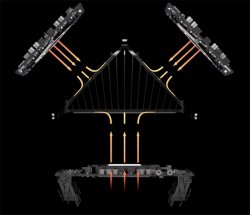It's amazing no one realize yet: THIS IS THE LEGENDARY xMAC FOLKS. Think of it:
- E5's - start at 4 cores;
- fire pro - from v4900 or w5000(entry level)
Can't help not to speculate(sorry) but starting price(quad core and dual v4900 or w5000; 4-8 GB RAM and 128GB flash) will be a shocking under 1900$.
Doubtful. The bulk of the bill of material costs for the current Mac Pro are CPU , RAM , HDD , GPU , power supply , case.
roughly in order of price ( the CPU and GPU flip in non entry configs )
CPU --> no real change.
GPU ---> costs
doubled . ( 1 GPU before , now two )
HDD --> increase. ( It would kind of really quirk if Mac Pro has less standard storage than a rMBP: 256GB. Not to mention the radical shift from 1TB default to a drop by an order of magnitude to ~100GB )
RAM ---> probably no real change ( 4x 2GB DIMMs )
power supply --> cheaper
case --> cheaper.
not to mention
3 TB controllers + infrastructure support ---> +$45-75
(versus physical x4 sockets and single PCI-e switch ... so probably net gain)
There is some cheaper stuff but it is in the tail end of the weighting. So would have to save $500 to get back to $1,999 and another $300+ to pay for the second GPU. The stuff chopped off is hardly $800 worth of stuff. It is doubtful they are going to undercut the iMac top end price. If they are under all they'd have to do is goose the GPU price higher ( faster and/or more VRAM) and they'd be above again.
There is a decent chance it may come in somewhere in $2,099-2,599 range (depending upon what kind of deal they wrangled for the parts for their entirely custom GPUs), but below $1,999 not so much. They didn't eject the two most expensive parts.
THIS IS THE xMAC we all asked for it since the 90's.... This is a fact no one seems to understand.
Not really. A healthy fraction of the xMac crowd wants to tinker. Another huge subset of that crowd want something firmly priced
inside the iMac's range; not the upper edge. Neither one of those factions is going to buy this.



